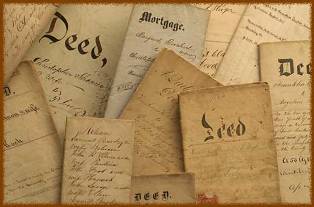Deeds-Land Records

Early Settlers' Land and Deeds
People who settled on land without entering it were called squatters; most of the people were squatters in this county, as there was no land office nearer that Kaskaskia, and it was not established till 1804. Shawneetown land office was established in 1812. Captain Cunningham, father of Mrs. Mary A. Logan was the agent there about the fifties. It was considered a sort of crime to enter land from under a squatter. In 1856 there was a special rate of twelve and one-half cents per acre, made to the settlers. This was called the Bit Act. There was a great scramble to get to the land office at this time. Men rode horse back, walked, pooled their horses and wagons to make a conveyance, in fact, any way to get to Shawneetown. Sometimes it would take ten days to make the journey, and wait your turn, since they stood in line as one would at a White House reception. Many people who had the money entered all the land they could for speculation.
The people of this section had to go to the old capitol, Kaskaskia, to enter land or for any legal business, to serve on juries or appear before them. The first deed recorded in Johnson County was not, of course, within the present limits, but appears on our records; it is from Robert Reynolds to Charles Davis, made in 1805 witnessed by Moses Oliver. This land is on the Mississippi River. Another deed was from John McElmuny to David McElmuny also on the Mississippi. It was made July 3, 1810. Frequent mention is made of McElmuny's Station in the description of land in the old Kaskaskia records. A station was a block house with a second story extending out over the lower one. The upper one was used as the living quarters so that the approach of the enemy could be easily seen, while the lower one was used to corral the live stock of the settlers.
The following is a list and the date of entry of those first entering land at Shawneetown in Johnson county proper or as it is now outlined; William McFatridge, May 23, 1815; John Elkins, Nov. 13, 1815; James Bain, Feb. 13, 1816; Hardy Johnson, June 26, 1817; Squire Choat, March 1818; Walton Gore, Oct. 5. 1818; John W. Gore, Oct. 10, 1818; Jacob Harvick, Nov. 15, 1818; Richard Marcer, July 10, 1818; Hezekiah West, Jan. 2, 1818; Andrew McGowan, Jan, 2, 1818; Elias Harrell, Sept. 25, 1820; Henry Beggs, 1831; Joel Thacker, 1839; Adam Harvick, 1818; James Finny, 1817; Martin Harvick, 1818; Joel Johnson, 1818; David Shearer, 1818; Thomas Dunsworth, 1819; David Elms, 1817; Abram Hendry, 1818; Benjamin McGinnis, 1817; Richard McGinnis, 1815; Emmet Elkins, 1818; Jeremiah Lissenby, 1818; John Plumer, 1819; (John Plummer entered quite a lot of land no doubt for speculation); E. J. J. Freeman, 1818; Daniel Delaney, 1818; Sidwell, Paxton and Chambers, 1818; (they also entered several tracks,) Henry Croswait and Richard Murry, 1818; Samuel Langdon, 1817; John McFatridge, 1832; Sallie Finney, 1837; Mathew Mathis, 1832; Richard Elliot, 1818; Joel S. Thacker, 1839; Francis Gehon, 1819; Adam and Martin Harvick; 1818; Louis J. Simpson and Millington Smith, 1817; J. O. Russell, 1816; Rix Carter and Pleasant Axley, 1818; N. Longworth, 1818; (ancestor of the present Nicholas Longworth, Republican leader in Congress from Ohio, and the son-in-law of the world famous Theodore Roosevelt.)
Extracted 11 Apr 2016 by Norma Hass from 1925 History of Johnson County written by Mrs. P. T. Chapman, page 153-154



